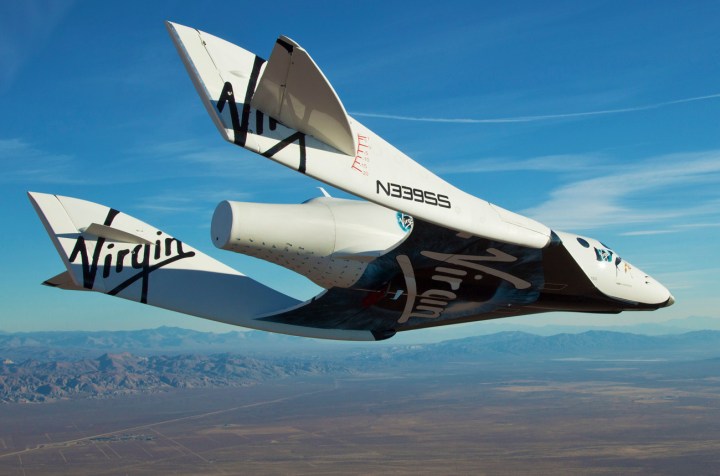Business Maverick, Sci-Tech
Virgin: (Another) small step for man, one giant leap for space tourism

Forget about the Cold War space race between the US and the USSR. The contemporary space race has long since gone commercial, with companies such as Richard Branson’s Virgin Galactic, Jeff Bezos’ Blue Origin, Elon Musks’ Space X, and Space Adventures competing to offer space tourism. Thus far, only the latter has taken paying customers to space (including our own Afronaut, Mark Shuttleworth). But with VSS Enterprise’s first manned test flight on Sunday, now it’s Branson’s venture that’s back in the headlines, which is just the way he likes it.
On Sunday 10 October, Virgin Galactic tested its SpaceShipTwo (SS2) model VSS Enterprise on its first manned solo glide flight. The mission was to assess the spacecraft’s ability to return back to Earth, and yes, it was accomplished. The craft was carried into space between the two fuselages of the four-engined mothership, a WhiteKnightTwo (WK2) model called Eve. VSS Enterprise went up to a height of 13.7 kilometres (about 45,000 feet). The flight was unpowered, with the pilots gliding the spacecraft back to Earth, and lasted about 11 minutes after the vehicle went solo.
Scaled Composites, the company that developed WK2 and SS2, already had stellar credentials before it hooked up with Virgin Galactic in 2005 – the previous year had it won the Ansari X Prize for its SpaceShipOne (SS1). On 21 June, 2004, SS1 became the first manned private vehicle to fly into space (incidentally, funded by Microsoft co-founder Paul Allen), and thus scooped up $10 million in prize money. Small change when it comes to manufacturing spaceships, but priceless if it attracts the attention of Branson.
Virgin Galactic and Scaled Composites formed a joint venture in 2005, called The Space Company, and Virgin will have sole rights to use the firm’s technology for the first 18 months of commercial space flights. The ongoing development of SS2 is, of course, part of the grand plan of implementing space tourism, and the weekend’s test flight played an important part in this. According to a statement by Virgin, the goals of the VSS Enterprise flight were to characterise the release dynamics, make an evaluation of handling characteristics, to see if stability and control compared with the simulation predictions and to carry out a descent to landing.
Watch: VSS Enterprise Manned Free Flight Test
Preliminary video footage shows the release to have been smooth and the landing at Mojave Air and Space Port, California appeared to be trouble-free. More extensive analysis is yet to be conducted, but both Scaled Composites and Virgin have said that all aspects of the flight – handling, flight controls and release mechanism – worked exactly as they were expected to. They would say that, but whatever expert analysis reveals, the flight certainly went better than a 2007 SS2 fuel flow test, which resulted in an explosion that killed three people.
Of course, spaceships are in their infancy, and more intensive and risky tests will need to be conducted before passengers are let on board, although Branson has suggested that paying customers could take up their places as early as late next year.
The chief executive of Virgin Galactic, George Whitesides, the erstwhile chief of staff at Nasa, said that finishing the experimental programme would be the biggest challenge. This involves, among other hurdles, getting a Federal Aviation Administration licence and starting the service from New Mexico’s Spaceport America soon. The inauguration for Spaceport America is to be held on October 22.
Considering that Space Adventures has halted its fledging space tourism programme until at least 2012, as well as the fact that tickets for VSS Enterprise are reasonably priced (what’s a couple of hundred thousand dollars, compared with a couple of million?), it looks as if the next men or women to visit space might just be flying the Virgin flag. If so, they’ll be in good company. Branson, of course, has reserved his ticket, and you can be sure that he wishes his company’s first space tourism flight would hurry up and take off already. DM
Read more: New Scientist, Cnet, Information Week.




















 Become an Insider
Become an Insider